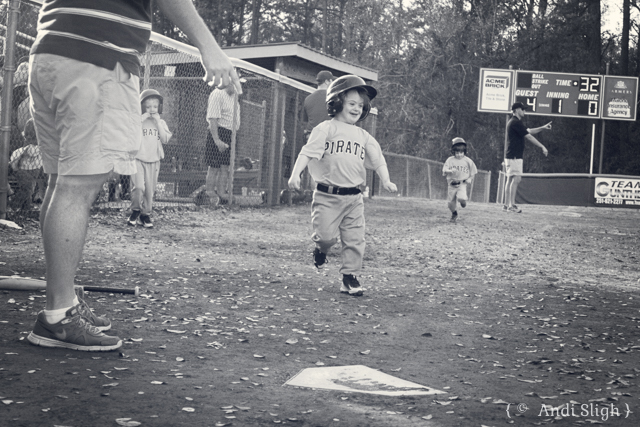
Last week, Nathan’s team played against a team with several kids we know, including the son of Lisa, a good friend of mine. Just before the game started, she came and sat next to me, expressing excitement at getting to see Nathan play (she’d heard the stories). He batted first again, and things went the way they go – a sham foul ball or two to prolong the at-bat experience, then hitting and running for real.
For his second at bat, our friend Dawn had wandered in and joined Lisa in the opposing stands, seated along the first base line. When he hit the ball, they both cheered loudly – a gesture that most parents would appreciate. Nathan, however, slowed way down to grin at them as he went by. For his third at bat, Dawn had moved over to my side, but Lisa still cheered and Nathan slowed way down again. He didn’t beat the ball to the base and was called out.
Lisa asked me before the game started if Nathan “knows what to do” in t-ball. I answered her the way I answer everyone who asks: he knows what to do, but he doesn’t get why. He knows to run fast to the bases, but he doesn’t seem to get that he needs to take the most direct route, without stopping, to beat the ball/player there. He checks up a step or two short of the base most of the time. At times (like when Lisa and Dawn were cheering), he run in a wide arc if there are fans to captivate.
His development has been a lot like his base running.
The books on childhood development lead you to believe that all of the different areas of development move together in a loose mass, going in the same direction at roughly the same pace, like a large crowd of people moving toward a stadium at game time. Checklists at the pediatrician’s office reinforce that belief – at age A, child should be doing X, Y, and Z, and so on.
That hasn’t been our experience.
Some milestones Nathan achieved early, others within the typical range of time, while others he is still working toward, long past the due date on the developmental charts. Some, like his speech, are progressing slowly, with fits and spurts along the way, and simply require patience on our part.
Others have us completely baffled.
Completing potty training has been the single most frustrating milestone to reach – and we still aren’t there – because he has done everything kids do before they completely transition to the potty, and has been doing them for ages, yet I still take delivery of pull-ups on a regular basis (thank you, Amazon Prime, for sparing me countless trips to the store!)
There’s a famous quote from the “Blink” episode of Doctor Who where the Doctor explains time travel to the episode’s protagonist, Sally Sparrow. He says, “People assume that time is a strict progression of cause to effect, but actually from a non-linear, non-subjective viewpoint – it’s more like a big ball of wibbly wobbly… time-y wimey… stuff.” The Doctor is talking about how the presumed linear progression of time as we know it is incorrect, but it’s actually a pretty good description for Nathan’s development.

I enjoyed your description of how Nathan and his progress is a lot like his base running, it gave me a fuller understanding of what you meant by non-linear progression. I remember following the helpful pediatric book for my son, then I lost the book, found it, flipped to the page where his age group was listed and realized he had met some of the ‘milestones,’ but skipped others. I couldn’t find the right page to start from, so that I could follow his growth. I set the book aside.
YES! I threw out those baby books after Sarah Kate was born. With preemies, they simply don’t apply. For Nathan, I never had any.